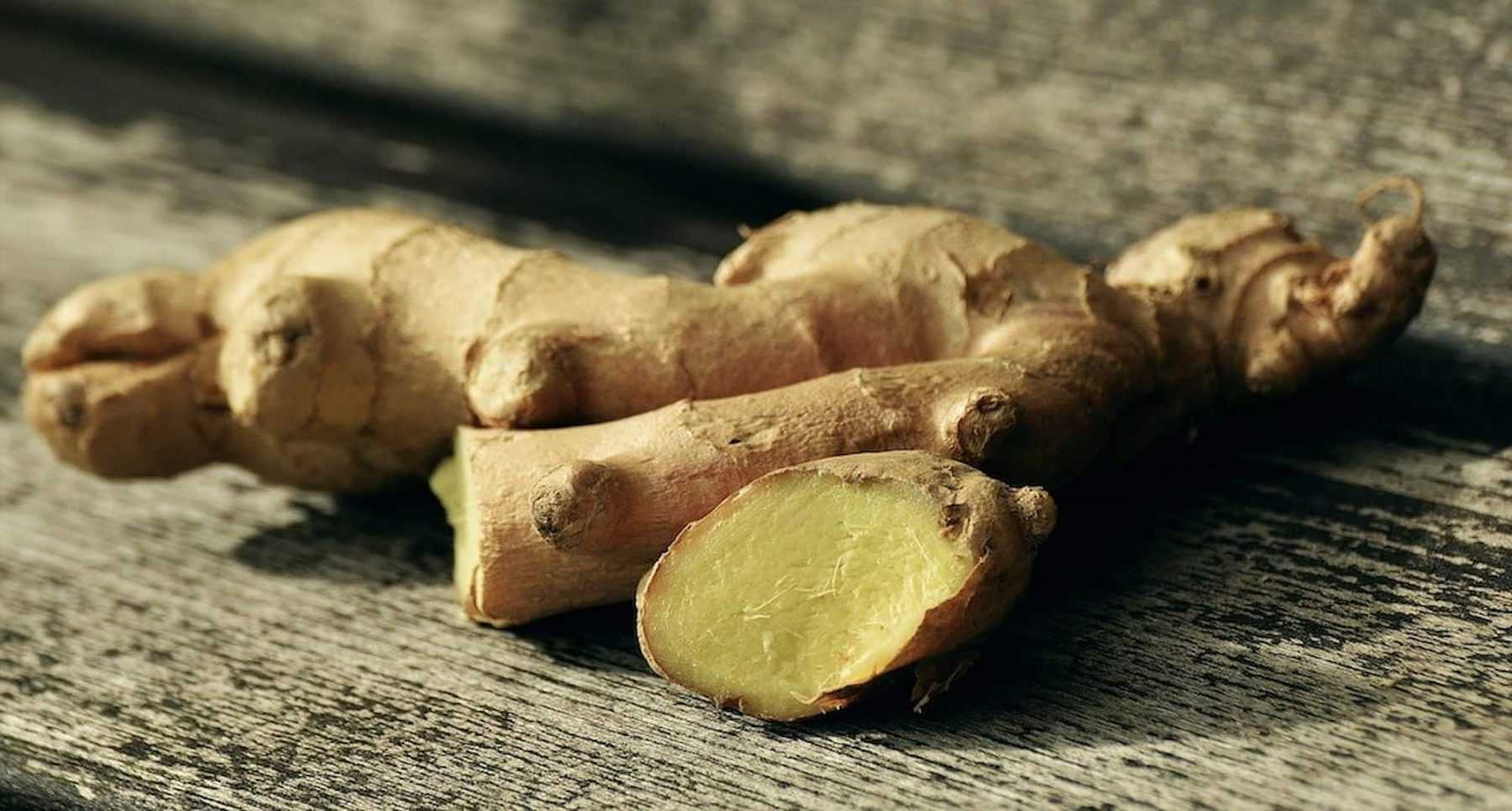
Ginger: Growing, Caring for and Harvesting
Contents
Ginger in a nutshell
- This subtropical aromatic plant can be grown in pots or directly in the ground, but only in the southernmost regions of the UK.
- Ginger propagates solely by division of its rootstock, which boasts a spicy, lemony flavour.
- It’s hardy down to -9°C but requires a warm, humid atmosphere for its shoots to develop.
- Its unusual flowering is fragrant.
- It reaches over 1 metre in height.
Our expert's word
Native to Asia, particularly India and Malaysia, ginger (Zingiber) is a subtropical exotic plant with specific cultivation requirements. Belonging to the Zingiberaceae family, ginger is a herbaceous rootstock plant, now produced exclusively in cultivated form.
In France, it can only be grown outdoors in territories with long summer seasons, such as the South. However, this tropical partial-shade plant thrives in pots when provided with a warm and humid atmosphere. If these growing conditions are met, ginger develops into a beautiful plant with bright green oblong and lanceolate leaves. From July to September, fragrant flowers measuring 15 to 20 cm, clustered in spikes, bloom. Eight to nine months after planting, new rootstocks form and can be harvested for consumption.
Botany
Botanical data
- Latin name Zingiber officinale
- Family Zingiberaceae
- Common name common ginger
- Flowering summer
- Height over one metre
- Exposure partial shade
- Soil type neutral
- Hardiness down to –12°C for some varieties
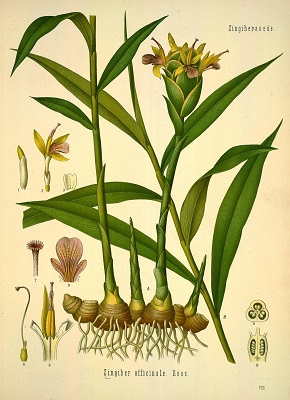
Botanical plate published in 1814.
Zingiber belongs to the Zingiberaceae family, which includes many condiment plants that produce common spices such as turmeric, cardamom or galangal. Likely originating from the humid tropical or subtropical regions of Asia, it no longer exists in the wild. Most herbaceous plants in the Zingiberaceae family share the characteristic of having an underground rootstock that forms tubercles, used as condiments since antiquity. This is the case with ginger (Zingiber), whose tuberous, fleshy and swollen rootstocks offer a pungent, slightly lemony flavour.
There are several species in the Zingiber genus, with aromatic ginger (Zingiber officinalis) being the most well-known of all. It is mainly cultivated in pots. In our more oceanic than tropical climate, it is easier to grow Japanese ginger (Zingiber mioga), which is hardy down to -15°C. Widely consumed in Japan, it produces a yellow root with a milder flavour than aromatic ginger. The flower buds of this species bloom at ground level in late summer and are edible.
Less common, Zingiber zerumbet produces inflorescences that yield a liquid used as shampoo, while Zingiber rubens, or red ginger, bears red flowers resembling orchids at ground level, much like its cousin Zinziber mioga.
As for the flower of Zinbiger spectabile, or beehive ginger, it is magnificent. The inflorescences resemble honeycombs and transition from a golden copper colour to a deep red at ripeness.
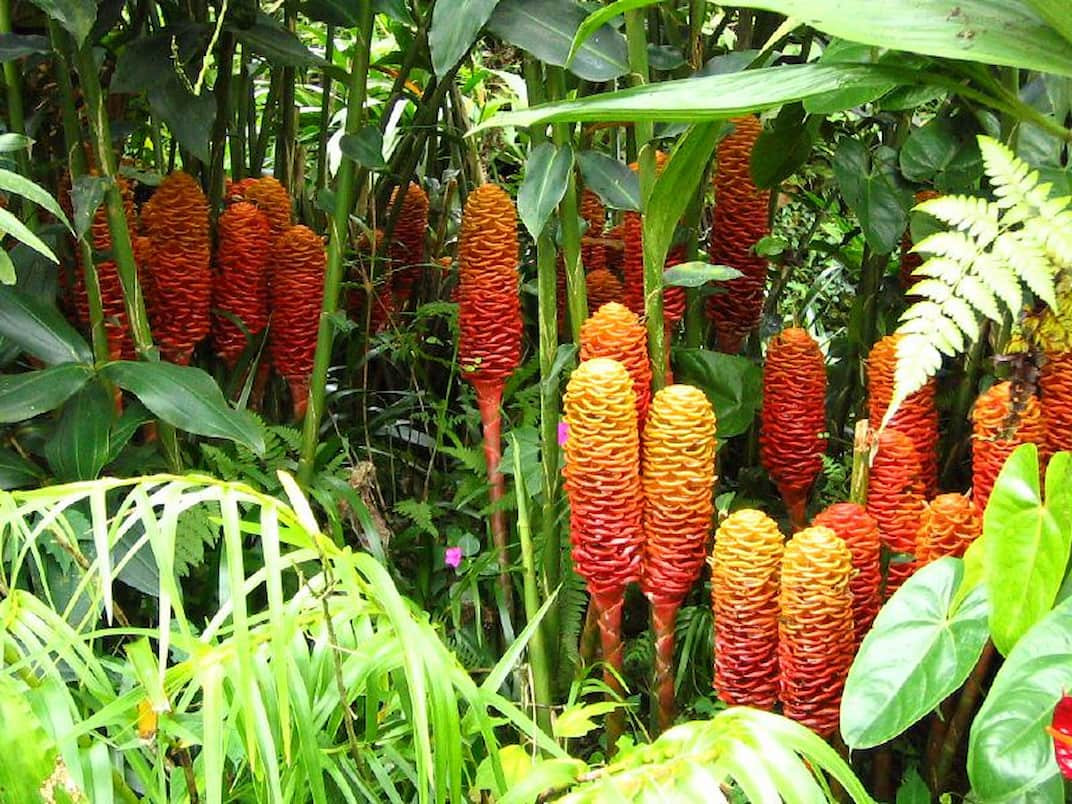
The inflorescences of Zinbiger spectabile evolve from golden copper to deep red
Other species are related to ginger: Alpinia galanga is impressive for its tall stature and highly ornamental flowers. Alpinia zerumbet ‘Variegata’ or shell ginger features variegated foliage in green, yellow and cream. As for Hedychiums or ornamental gingers, they are covered in late summer with stunning yellow or orange flower spikes.
At first glance, Zingiber officinalis could almost be mistaken for a maize plant. It forms long stems that can reach 2 metres in its natural habitat, but usually around 1 metre in our climate, from which oblong, lanceolate leaves emerge. Bright green in colour, these sheathing leaves grow in clumps and measure between 10 and 15 cm long. They give the plant a particularly lush appearance. Unfortunately, in our climate, the flowers do not always appear.
In autumn, the aerial parts of Zingiber turn yellow and dry out, as the plant enters dormancy. This is the perfect time to harvest the rootstocks.
Between July and September, unusual inflorescences bloom on these stems. White to yellow, sometimes dusted with red on the lips, the flowers of aromatic ginger bloom amidst green and yellow bracts that are tough and dense. They measure 10 to 15 cm and grow in irregular spikes.
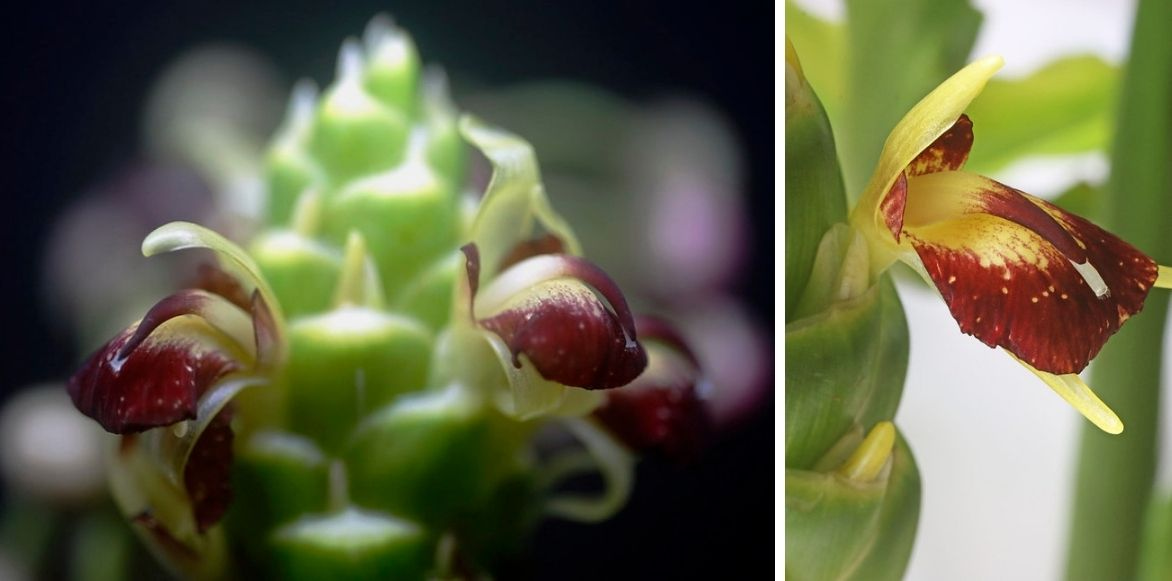
The inflorescences of Zingiber officinalis
After flowering, the flowers give way to axillary spikes containing black seeds enclosed in trivalve capsules. In contrast, those of Zinbiger mioga are pale yellow and appear at the base of the stem, at ground level.
But ginger is mainly cultivated for its tuberous rootstocks, most of which are edible and widely used in Asian and Indian cuisines. The Japanese also appreciate the flower buds of Zingiber mioga, freshly emerged from the soil. The rootstocks of Zingiber are juicy and fleshy. They possess numerous medicinal and aromatic properties. Whether consumed fresh, dried, powdered or candied, ginger is known for its tonic (not aphrodisiac!), digestive, analgesic, expectorant and anti-haemorrhagic properties…
Zingiber officinale is a tropical plant that is quite difficult to cultivate in open ground due to its need for warmth and humidity. However, Zinbiger mioga is hardier and adapts well to French gardens. Just cover the rootstock with a good layer of mulch to keep it warm during the cold season.
The best species
[product sku=”2944″ blog_description=”Ginger can be grown in open ground only in regions with long periods of warmth” template=”listing1″ /]
[product sku=”83494″ blog_description=”More hardy, Japanese ginger can be grown in open ground under protective mulch” template=”listing1″ /]
Discover other Asimina trees
View all →Available in 2 sizes
Available in 1 sizes
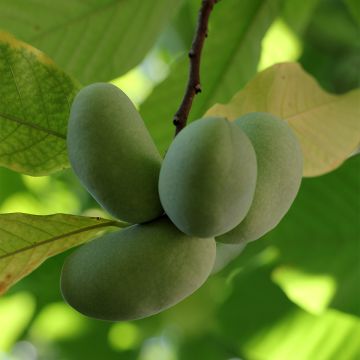
Available in 1 sizes
Available in 1 sizes
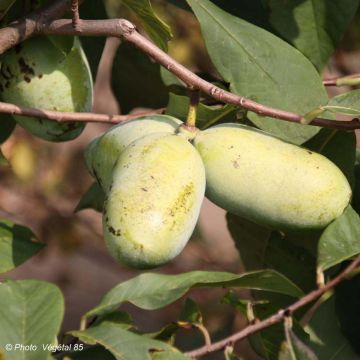
Available in 2 sizes
Available in 1 sizes
Available in 1 sizes
Available in 1 sizes
Available in 1 sizes
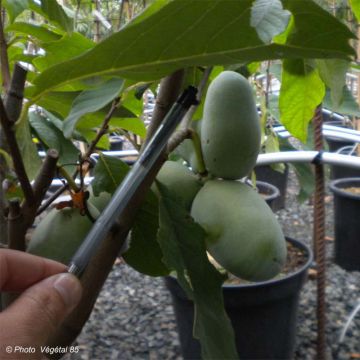
Available in 3 sizes
Planting
Where to plant?
To recap, ginger is a subtropical plant so it needs warmth, moderate light and humidity – conditions that can be hard to replicate in our regions. That said, it can be grown in the garden in neutral to slightly acidic soil that is light, humus-bearing, rich and well-drained. It will require a temperature of at least 25°C for several months to develop properly. Similarly, watering should be regular but never excessive. During its winter dormancy, the soil should remain relatively dry.
As for positioning, it should mimic its natural habitat. A partially shaded spot suits it perfectly, especially avoiding direct sunlight during the hottest hours of the day.
Zingiber mioga is far less demanding. Highly ornamental, it can be grown outdoors thanks to its hardiness down to –15°C, in soil that stays cool but well-drained.
For both varieties, winter mulching is essential for outdoor cultivation. Similarly, protection from rain is recommended.
Both varieties are easier to grow in pots. The pot should be placed in a spot with a consistent temperature between 20 and 25°C and moved outdoors to partial shade in summer. Don’t forget to bring it back indoors by September.
When to plant?
Ideally, planting takes place in spring, in May for outdoor planting and between March and June for pot cultivation.
However, if you wish to grow your ginger rootstock in a pot, planting can also be done in autumn.
How to plant?
Before planting your rootstock, it’s recommended to soak it in water to encourage sprouting. 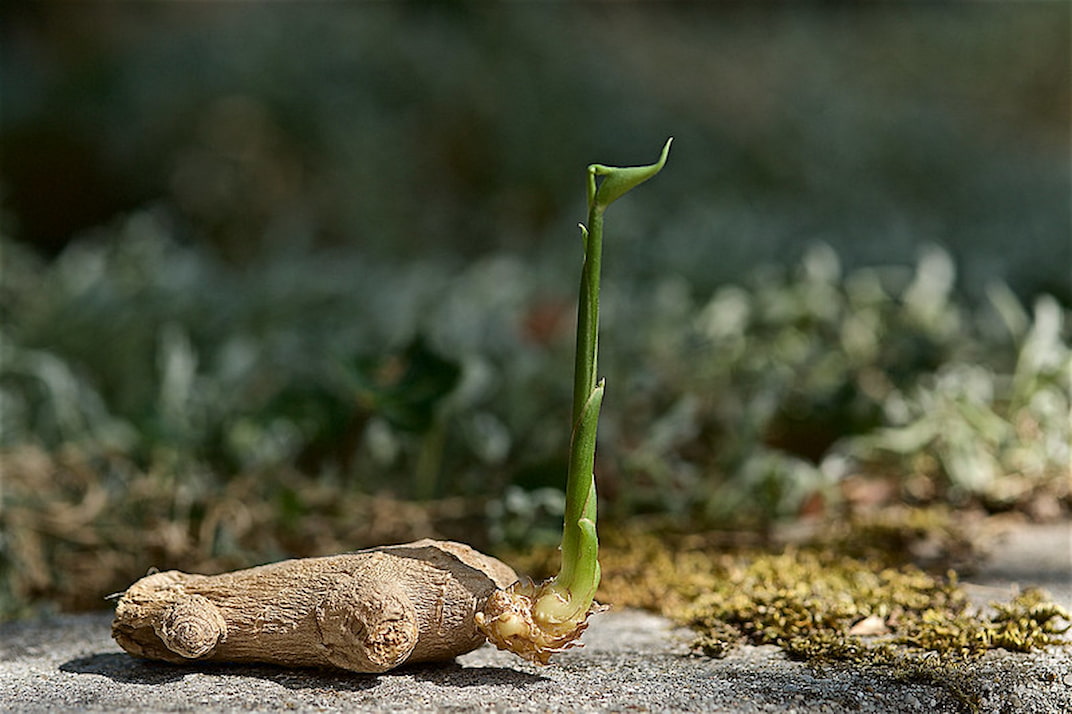 Only half of the rootstock should be submerged. Once several roots and shoots have appeared, you can plant it.
Only half of the rootstock should be submerged. Once several roots and shoots have appeared, you can plant it.
In the garden
Plant your Zingiber rootstock in loosened garden soil enriched with compost or good-quality potting mix. The soil must be sufficiently warmed to welcome the young shoot. Bury the rootstock lightly, leaving part exposed to encourage stem and leaf development.
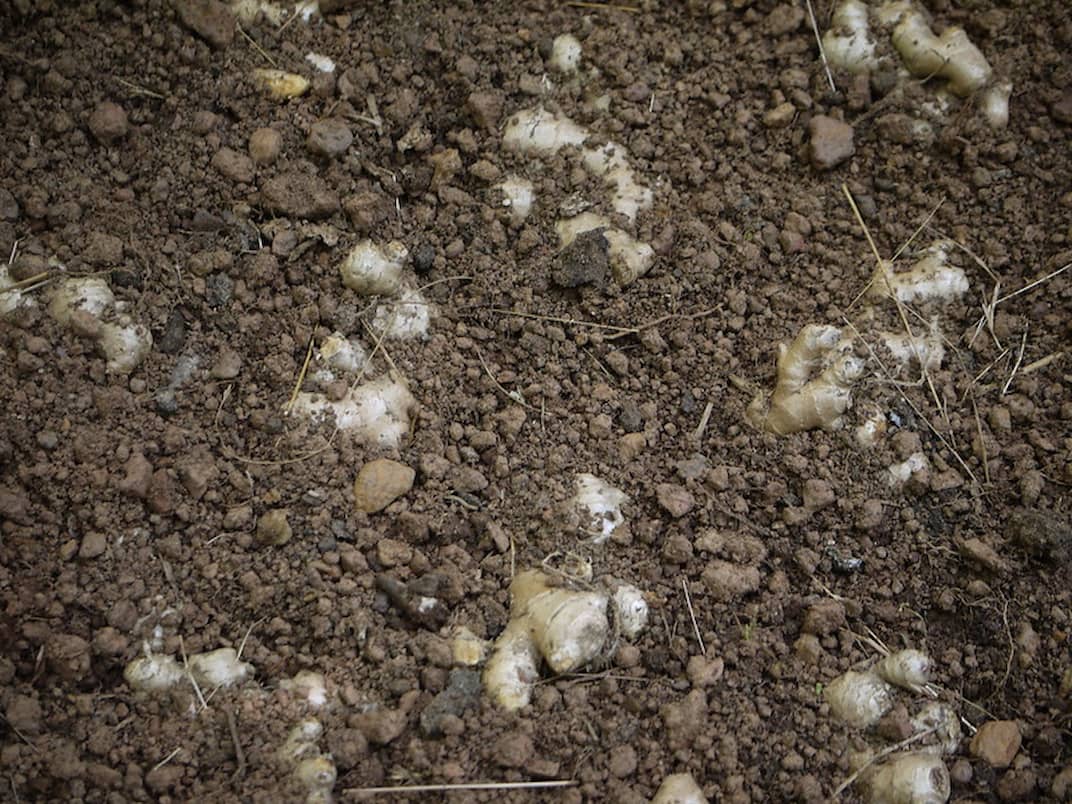
When planting, the ginger rootstock should slightly emerge
Avoid compacting the soil too much but water thoroughly.
In a pot:
- Choose a pot at least 30 cm in diameter and relatively deep.
- Place a layer of gravel or clay pebbles at the bottom to aid drainage.
- Fill the pot with a medium composed of 1/3 garden soil, 1/3 compost or potting mix, and 1/3 sand.
- Plant the rootstock 2–3 cm deep, leaving part exposed above the medium.
- Firm lightly.
- Water thoroughly.
- Place the pot in a spot with a temperature of at least 20–25°C, and move outdoors in summer.
Maintenance
Two key actions are essential to ensure the growth and survival of ginger: regular watering and mulching if your rootstock is planted directly in the ground.
The Zingiber requires a humid atmosphere, so the soil should remain moist without ever becoming waterlogged. Watering should therefore be regular but not excessive, especially once the leaves reach 20 cm in height. Typically, in early autumn, the leaves begin to yellow, at which point watering should cease as the harvest of the rootstock is near.
When planted in the ground, the rootstock must be protected in winter with a thick mulch layer of at least 20 cm. Similarly, it should be shielded from rain to prevent the soil from becoming waterlogged. However, once the leaves have withered, lack of light is not an issue.
Pruning is unnecessary.
The Zingiber is rarely affected by diseases and parasitic pests. However, when grown in pots, due to the warm and humid environment it requires, mealybugs may infest its foliage. Recognisable by their cottony clusters and the sticky appearance of the leaves, mealybugs can be removed using a cotton pad soaked in a mixture of soapy water and 90° alcohol or by spraying a solution made of one teaspoon of liquid black soap, one teaspoon of 90° alcohol, and one teaspoon of rapeseed oil, diluted in one litre of water. Remember to ventilate the room where the Zingiber is kept and, if temperatures permit, place it outside on a rainy day.
Harvest
Between 8 to 9 months after planting, the rootstock can be harvested. You must wait until all the leafy aerial parts have dried out. Around September or October, and absolutely before the first frosts, you can lift the rootstocks with a garden fork if the ginger is planted in open ground, or by pulling up the young plant if it’s grown in a pot. Allow it to dry for a few days in the garden.
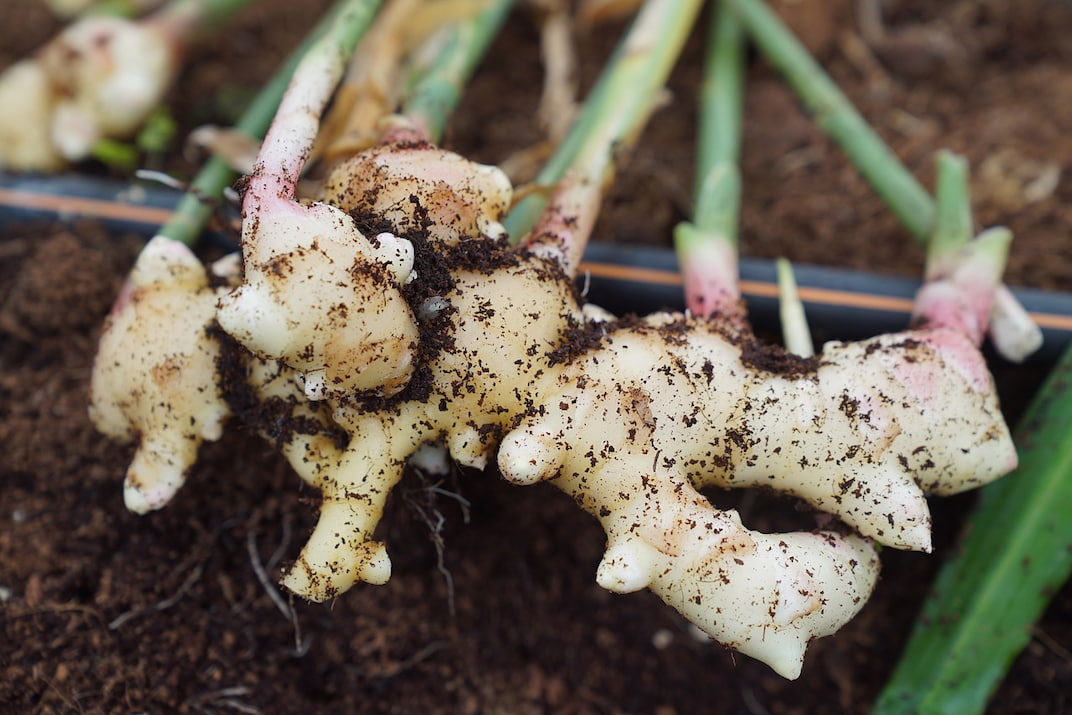
Ginger rootstock at harvest time
The harvest can also take place 6 months after planting, but the flavour of the rootstock will be different – milder and less lemony.
You can store your rootstock for 3 to 4 weeks in the refrigerator.
The Zingiber mioga is harvested differently. As the flower buds and young shoots are edible, pick them as soon as they appear. As for the rootstocks, they are harvested like those of its cousin, in autumn.
Propagation
Ginger does not propagate by seed. To obtain new young plants, propagation is done through the rootstock. During the harvest, keep portions of rootstocks which you can (re)pot during winter. The rootstock enters vegetative dormancy. Keep your pot indoors in a place that’s not too cold.
In spring, when the buds awaken, it’s time to divide and plant new rootstocks.
Association
The cultivation conditions of Zingiber only allow it to be paired with tropical or subtropical plants which, when planted in the ground, can only thrive in regions with a mild climate. Thus, the lush green foliage of ginger combined with the beautiful rhizomatous plant Curcuma alismatifolia with its white, pink or red flowers, also known as Siam Tulip, adds an undeniable exotic touch to a terrace or southern garden. Ginger also pairs well with Alocasia macrorrhiza or Elephant Ear, with its enormous glossy green leaves. It also beautifully complements the splendid flowers of Strelitzia reginae or Bird of Paradise, or the vibrant Abutilons.
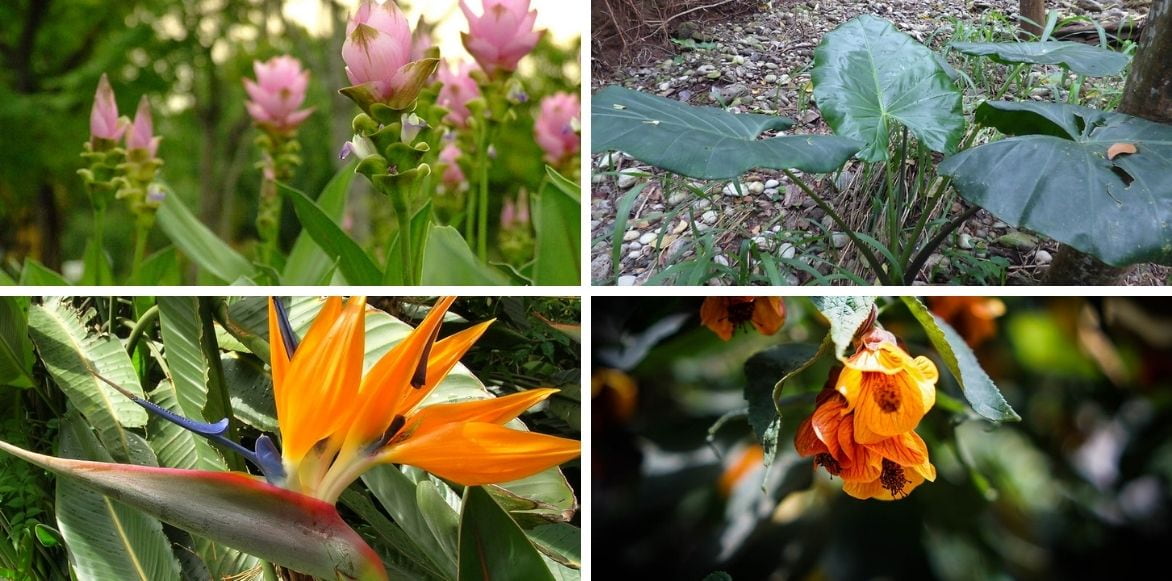
Curcuma alismatofolia, Alocasia macrorrhiza, Strelitzia reginae, Abutilon
The Various Uses of Ginger
Ginger has been part of culinary traditions for millennia, valued for both its flavour and medicinal properties. It can be consumed fresh or dried. When fresh, the rootstock is slightly tangy, sweet, juicy and very tender. Once dried, it becomes more pungent in taste and fibrous in texture. It can then be grated or cooked in dishes.
Ginger is also used as a spice, incorporated into blends such as garam masala, curry or ras-el-hanout. It flavours desserts like gingerbread and is enjoyed candied as well.

Ginger is an ingredient in gingerbread
Ginger also features in strongly flavoured beverages such as ginger ale or ginger beer, widely used in cocktails. In Africa, it’s consumed as ginger juice, and it can also be enjoyed in herbal teas or infused in regular tea.
To go further
- To complete your spice garden, discover our selection of 7 exotic aromatic plants
- To create other combinations, choose from our exotic and hardy plants
- To move from garden to kitchen, our 7 spices to grow
- How to grow ginger at home? Angélique explains everything!
- Subscribe!
- Contents


































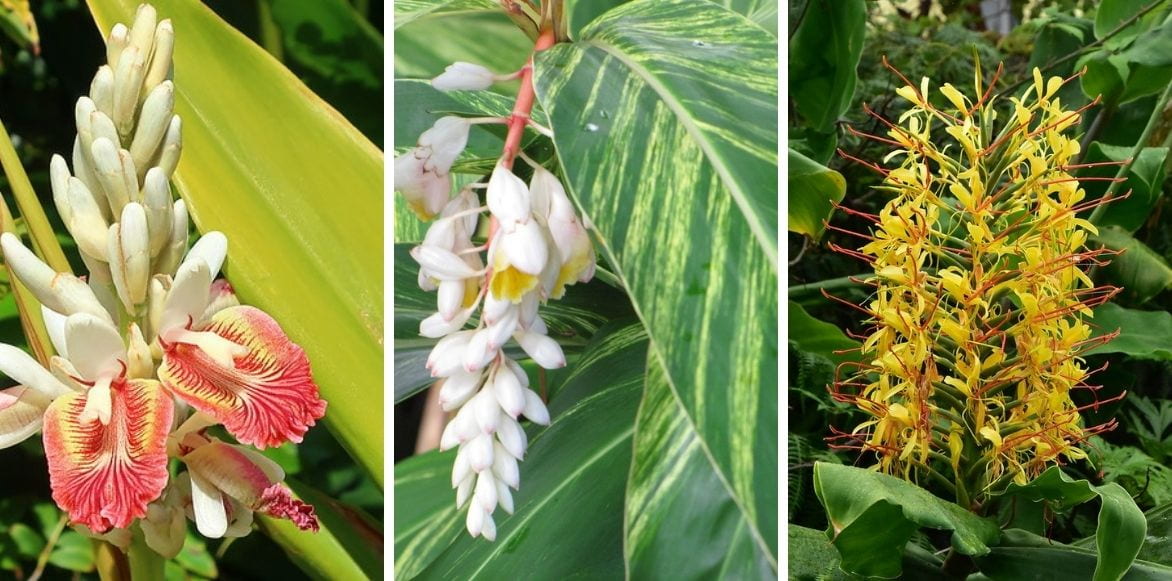
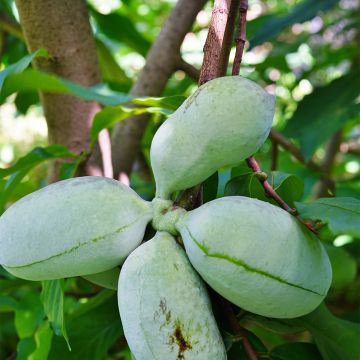
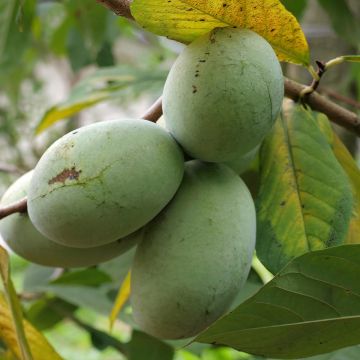
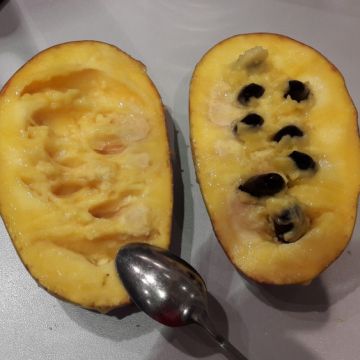
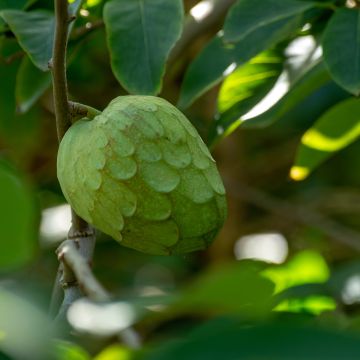
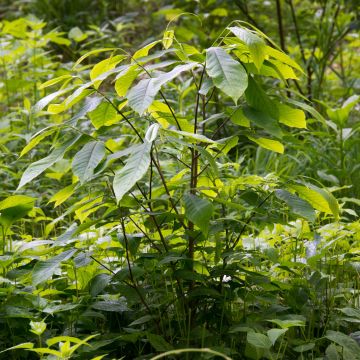
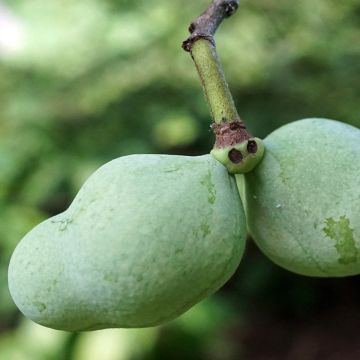
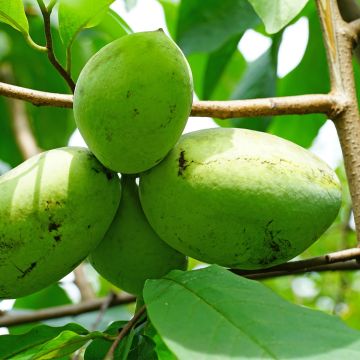
Comments